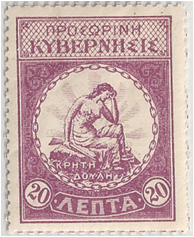ALBUM – view my Crete, Theriso Revolution album
TRANSITION CHART – Crete
Fast Facts
Region: Aegean Sea
Group: Autonomous Crete / Occupation by Britain, Russia, Italy, and France
Classification: Revolution
Regime: Autonomous Crete / Occupation by Britain, Russia, Italy, and France
Key Dates:
1896 – Rebellion on Crete against the Ottomans
1897 – Multinational forces land on Crete
1901, Mar 20 – Venizelos dismissed as Crete Prime Minister
1905, Mar 10 – Theriso Revolution
1905, Jul 18 – Martial law declared
1905, Aug 15 – Reforms agreed by Cretan Assembly and subsequently agreed by Multinational Powers
1909 – Multinational Forces withdraw
1913 – Unification with Greece recognized after the Balkan wars
Following Regime: Autonomous Crete
Scott Catalogue: unlisted (SG 0115-0118, Michel 6-11)
Pick Catalogue: none
History

Disagreements soon emerged between the Prince George and Venizelos. One major issue was the demand for the construction of a palace for Prince George. Venizelos protested that a palace would be a symbol of permanence for a regime which he intended to be temporary. His overall goal was the ultimate union with Greece. While this greatly offended the prince, the demand was eventually dropped.
After about 1-1/2 years in office, Venizelos tendered his resignation on two occasions: first on 5 March 1901, citing health reasons, and then on 18 March, explaining that he could not work while in permanent disagreement with his colleagues and the High Commissioner. George refused to accept his resignation, instead preferring to dismiss him for insubordination. On 20 March, posters on the walls of Chania announced the Prince’s dismissal of Venizelos.
For the next 3 years, Venizelos led a strong political opposition, which eventually resulted in the Thériso Revolution. On 10 Mar 1905, a group of rebels gathered in Theriso and declared “the political union of Crete with Greece as a single free constitutional state”. The resolution was presented to the Great Powers, where it was argued that the illegitimate provisional arrangement was preventing the island’s economic growth and the only logical solution to the “Cretan Question” was the unification with Greece. Prince George, with the approval of the Great Powers, replied to the rebels to cease their revolution, or he would be forced to take military action. However, more Cretan deputies joined with Venizelos in Theriso. Finally, the Great Powers’ consuls met with Venizelos in Mournies in an attempt to achieve an agreement to no result.
On 18 Jul, 1905 the Great Powers declared martial law, but it didn’t deter the rebels. On 15 Aug, the regular assembly in Chania voted in favor of most of the reforms that Venizelos proposed. In a subsequent meeting with Venizelos, The Great Powers’ consuls accepted the reforms which ended the revolt and resulted in the resignation of Prince George as High Commissioner.
The Great Powers assigned the authority for selecting the island’s new High Commissioner to King George I of Greece, thereby nullifying the Ottoman suzerainty. Greek officers and non-commissioned officers were allowed to undertake the organization of the Cretan protection, and soon the foreign troops began to withdraw from the island. In 1909 the last of the occupying forces left the island, and in 1913, Crete’s unification was fully recognized after the Balkan Wars.
Eleftherios Venizelos, went on be one of the most influential people in modern Greek history, serving as Prime Minister for multiple terms, and bringing Greek Society and Culture into modern times.
Stamps
 ALBUM
ALBUM
On 15 Feb, 1905, the Revolutionaries at Therissos issued a set of 6 stamps as propaganda pieces. While the stamps were never placed in official use, they were made available to philatelic collectors. The stamps, which were of fairly good quality, based on the circumstances, had two basic designs. One featured a woman holding a rifle, with the script “Crete enslaved”, and was issued in four different valuations. The second depicted an image of Prince George and was issued in two different denominations. There are many forgeries which exist. The real stamps were issued in thin white paper, and many of the forgeries are on a thicker brownish paper. A guide for distinguishing forgeries is shown in my album, and I have displayed two different perforation varieties of the forgeries (14-1/2 and 11).
Banknotes
none issued by the Revolutionaries.
Links
A Prince Departs – history of the Theriso Revolution at Historical Musings
The History of the Union of Crete with Greece
Theriso Revolt, Wikipedia
Eleftherios Venizelos from Wikipedia






I came across your Crete Therison Revolution description of forgeries at another site and found your site. Thank you for doing such a great job with illustrations. I was wondering if you had additional forgery results for Crete, Greece and other areas of interest, and may be Turkey.
Hi Bill, thank you for your comments. I am not an expert in forgeries, but will include information in my albums if I have enough knowledge on how to determine forgeries, and also have enough examples of both genuine and forged stamps in my collection to make the explanation worthwhile. The stamps from the Therso revolution was such country. Unfortunately, (with the exception of the British occupation stamps in Crete), I don’t have enough knowledge about other Crete stamp forgeries. While I don’t have enough examples in my collection in the British Occupation to make a good display in my album, I do, however include a link in the main article which covers forgeries in these occupation stamps. It can be found at: Determining Forgeries for British Occupation of Crete Stamps
Thanks again for visiting DC Stamps.
Michael